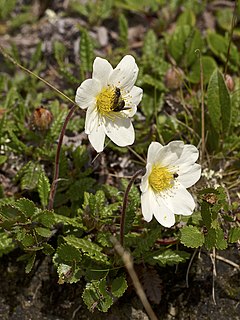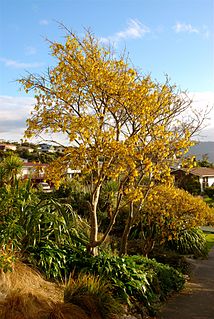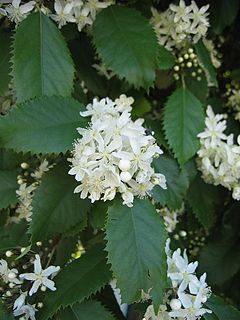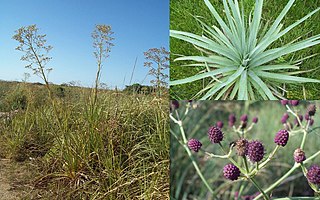
The Royal Horticultural Society (RHS), founded in 1804 as the Horticultural Society of London, is the UK's leading gardening charity.

Dryas octopetala, the mountain avens, eightpetal mountain-avens, white dryas or white dryad, is an Arctic–alpine flowering plant in the family Rosaceae. It is a small prostrate evergreen subshrub forming large colonies. The specific epithet octopetala derives from the Greek octo (eight) and petalon (petal), referring to the eight petals of the flower, an unusual number in the Rosaceae, where five is the normal number. However, flowers with up to 16 petals also occur naturally.

Pelargonium is a genus of flowering plants which includes about 280 species of perennials, succulents, and shrubs, commonly known as geraniums, pelargoniums, or storksbills. Geranium is also the botanical name and common name of a separate genus of related plants, also known as cranesbills. Both genera belong to the family Geraniaceae. Carl Linnaeus originally included all the species in one genus, Geranium, and they were later separated into two genera by Charles Louis L'Héritier de Brutelle in 1789.

Sophora microphylla, common name kōwhai, is a species of flowering plant in the family Fabaceae, native to New Zealand. Growing to 8 m (26 ft) tall and broad, it is an evergreen shrub or small tree. Each leaf is 10 cm (4 in) long with up to 40 pairs of shiny oval leaflets. In early spring it produces many racemes of pea-like yellow flowers.

Dryas is a genus of perennial cushion-forming evergreen dwarf shrubs in the family Rosaceae, native to the arctic and alpine regions of Europe, Asia and North America. The genus is named after the dryads, the tree nymphs of ancient Greek mythology. The classification of Dryas within the Rosaceae has been unclear. The genus was formerly placed in the subfamily Rosoideae, but is now placed in subfamily Dryadoideae.

Erica tetralix, the cross-leaved heath, is a species of flowering plant in the family Ericaceae, native to western Europe, from southern Portugal to central Norway, as well as a number of boggy regions further from the coast in Central Europe such as Austria and Switzerland. In bogs, wet heaths and damp coniferous woodland, E. tetralix can become a dominant part of the flora. It has also been introduced to parts of North America.

Chirita was an Old World genus of the flowering plant family Gesneriaceae, native to Indo-Malaysia, S. E. Asia, and southern China. In 2011, the species in the genus were reassigned to several genera, with the type species assigned to the genus Henckelia, so that Chirita became a synonym, no longer recognized.

Quercus canariensis, the Algerian oak, Mirbeck's oak or zean oak, is an oak in the section Quercus sect. Mesobalanus, native to southern Portugal, Spain, Tunisia, Algeria and Morocco. Despite the scientific name, it does not occur naturally today in the Canary Islands, though it may have in the past.

Kalmia angustifolia is a flowering shrub in the family Ericaceae, commonly known as sheep laurel. It is distributed in eastern North America from Ontario and Quebec south to Virginia. It grows commonly in dry habitats in the boreal forest, and may become dominant over large areas after fire or logging. Like many plant species of infertile habitats it has evergreen leaves and mycorrhizal associations with fungi. It is also found in drier area of peat bogs.

Hoheria is a genus of six species of flowering plants in the family Malvaceae. All are endemic to New Zealand. The genus name is a latinization of the Māori language name, houhere. That name, as well as lacebark and ribbonwood, are often used as common names. The name lacebark comes from the lace-like fibrous inner bark layer.

Acacia pravissima, commonly known as Ovens wattle, Oven wattle, wedge-leaved wattle and Tumut wattle, is a species of flowering plant in the legume family Fabaceae. It is an evergreen shrub native to Victoria, the South West Slopes and Southern Tablelands of New South Wales, Australia.

Oscularia deltoides, the deltoid-leaved dewplant, dassievygie or sandsteenvygie is a species of flowering succulent plant in the fig-marigold family Aizoaceae that is native to the south-western Cape, South Africa.

Thymus pulegioides, common names broad-leaved thyme or lemon thyme, is a species of flowering plant in the family Lamiaceae, native to Europe. Growing to 5–25 cm (2–10 in) tall by 25 cm (10 in) wide, it is a small spreading subshrub with strongly aromatic leaves, and lilac pink flowers in early summer. The specific epithet pulegioides highlights its similarity to another species within Lamiaceae, Mentha pulegium (pennyroyal).

Atriplex prostrata, called the spear-leaved orache, hastate orache, thin-leaf orache, triangle orache, and fat hen, is a widespread species of flowering plant in the saltbush genus Atriplex, native to Europe, Macaronesia, northern Africa, Ethiopia, the Middle East, western Siberia, and Central Asia, and introduced to temperate North America, South America, Australia, New Zealand, Korea, Japan, and Primorsky Krai in far eastern Russia. It is a facultative halophyte.
Nierembergia linariifolia, called the narrow-leaved cupflower, is a species of plant described by Robert Graham. Nierembergia linariifolia is part of the genus Nierembergia and the family Solanaceae. It has gained the Royal Horticultural Society's Award of Garden Merit.

Phlomis longifolia, the long-leaved Jerusalem sage, is a species of flowering plant in the mint and sage family Lamiaceae, native to the hills of Turkey and Lebanon.
Cyananthus microphyllus, called the small-leaved bluebell-flower, is a species of flowering plant in the genus Cyananthus, native to the western Himalayas, Nepal, and Tibet. It has gained the Royal Horticultural Society's Award of Garden Merit.

Eryngium pandanifolium, called the pandan-like-leaved eryngo, is a species of flowering plant in the genus Eryngium, native to Brazil, Paraguay, Uruguay, and Argentina, and introduced in Australia and New Zealand. It has gained the Royal Horticultural Society's Award of Garden Merit.
Euphorbia nereidum, called the nerium-leaved spurge, is a species of flowering plant in the genus Euphorbia, native to Morocco. It has gained the Royal Horticultural Society's Award of Garden Merit.
Philodendron angustisectum, called the cut-leaved philodendron, is a species of flowering plant in the genus Philodendron, distjunctly found in Bolivia and Colombia. It has gained the Royal Horticultural Society's Award of Garden Merit as a hothouse ornamental.

















